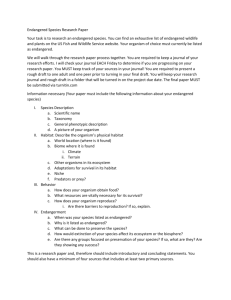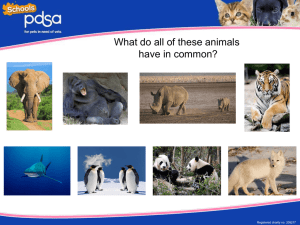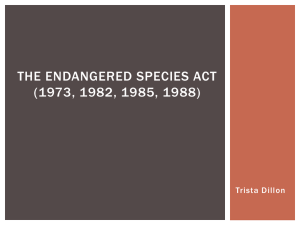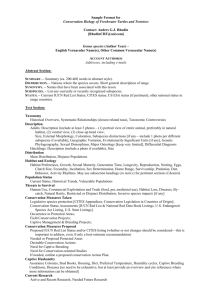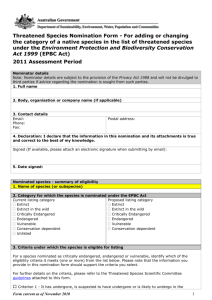Appendix 2 - Template for preparing a species status review (DOCX
advertisement
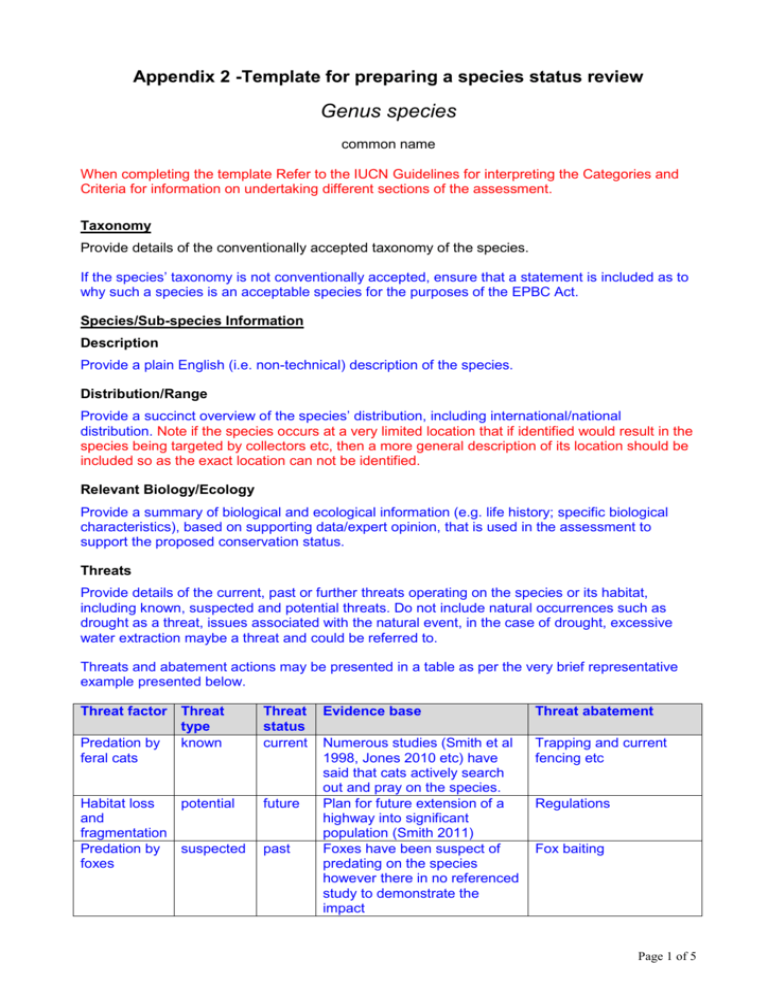
Appendix 2 -Template for preparing a species status review Genus species common name When completing the template Refer to the IUCN Guidelines for interpreting the Categories and Criteria for information on undertaking different sections of the assessment. Taxonomy Provide details of the conventionally accepted taxonomy of the species. If the species’ taxonomy is not conventionally accepted, ensure that a statement is included as to why such a species is an acceptable species for the purposes of the EPBC Act. Species/Sub-species Information Description Provide a plain English (i.e. non-technical) description of the species. Distribution/Range Provide a succinct overview of the species’ distribution, including international/national distribution. Note if the species occurs at a very limited location that if identified would result in the species being targeted by collectors etc, then a more general description of its location should be included so as the exact location can not be identified. Relevant Biology/Ecology Provide a summary of biological and ecological information (e.g. life history; specific biological characteristics), based on supporting data/expert opinion, that is used in the assessment to support the proposed conservation status. Threats Provide details of the current, past or further threats operating on the species or its habitat, including known, suspected and potential threats. Do not include natural occurrences such as drought as a threat, issues associated with the natural event, in the case of drought, excessive water extraction maybe a threat and could be referred to. Threats and abatement actions may be presented in a table as per the very brief representative example presented below. Threat factor Threat type Predation by known feral cats Threat status current Habitat loss potential and fragmentation Predation by suspected foxes future past Evidence base Threat abatement Numerous studies (Smith et al 1998, Jones 2010 etc) have said that cats actively search out and pray on the species. Plan for future extension of a highway into significant population (Smith 2011) Foxes have been suspect of predating on the species however there in no referenced study to demonstrate the impact Trapping and current fencing etc Regulations Fox baiting Page 1 of 5 Assessment of available information in relation to the EPBC Act Criteria and Regulations 1. Population size reduction (reduction in total numbers) Population reduction (measured over the longer of 10 years or 3 generations) based on any of A1 to A4 Critically Endangered Very severe reduction Endangered Severe reduction Vulnerable Substantial reduction A1 ≥ 90% ≥ 70% ≥ 50% A2, A3, A4 ≥ 80% ≥ 50% ≥ 30% A1 A2 Population reduction observed, estimated, inferred or suspected in the past and the causes of the reduction are clearly reversible AND understood AND ceased. Population reduction observed, estimated, inferred or suspected in the past where the causes of the reduction may not have ceased OR may not be understood OR may not be reversible. A3 Population reduction, projected or suspected to be met in the future (up to a maximum of 100 years) [(a) cannot be used for A3] A4 An observed, estimated, inferred, projected or suspected population reduction where the time period must include both the past and the future (up to a max. of 100 years in future), and where the causes of reduction may not have ceased OR may not be understood OR may not be reversible. (a) direct observation [except A3] (b) an index of abundance appropriate to the taxon based (c) on any of the following : (d) a decline in area of occupancy, extent of occurrence and/or quality of habitat actual or potential levels of exploitation (e) the effects of introduced taxa, hybridization, pathogens, pollutants, competitors or parasites Evidence: Provide a summary of supporting data/expert opinion relevant to the criterion. A finding of ‘has undergone’ requires the support of quality data, whereas this requirement defers increasingly to weaker data and the judgment of the experts for ‘suspected reduction’ or a ‘likelihood of reduction’. If the first part of the criterion can be easily determined, it must be then determined whether the reduction is/would be very severe, severe or substantial. In doing this regard must be had to the species’ relevant biology and ecology and the Indicative Thresholds, thereby taking into account the relationship between the reduction in numbers and the factors that are relevant to the species’ risk of extinction in the wild (or, alternatively, the factors relevant to the species’ prospects of survival in the wild). If no evidence is provided just say insufficient information to assess against this criteria. Criterion 2. Geographic distribution as indicators for either extent of occurrence AND/OR area of occupancy Critically Endangered Very restricted Endangered Restricted Vulnerable Limited B1. Extent of occurrence (EOO) < 100 km2 < 5,000 km2 < 20,000 km2 B2. Area of occupancy (AOO) < 10 km2 < 500 km2 < 2,000 km2 =1 ≤5 ≤ 10 AND at least 2 of the following 3 conditions: (a) Severely fragmented OR Number of locations (b) Continuing decline observed, estimated, inferred or projected in any of: (i) extent of occurrence; (ii) area of occupancy; (iii) area, extent and/or quality of habitat; (iv) number of locations or subpopulations; (v) number of mature individuals (c) Extreme fluctuations in any of: (i) extent of occurrence; (ii) area of occupancy; (iii) number of locations or subpopulations; (number of mature individuals Scientific name (common name) status review Page 2 of 5 Evidence: Provide a summary of supporting data/expert opinion relevant to the criterion. If no evidence is provided just say insufficient information to assess against this criteria. Criterion 3. Population size and decline Critically Endangered Very low Endangered Low Vulnerable Limited < 250 < 2,500 < 10,000 Very high rate 25% in 3 years or 1 generation (whichever is longer) High rate 20% in 5 years or 2 generation (whichever is longer) Substantial rate 10% in 10 years or 3 generations (whichever is longer) ≤ 50 ≤ 250 ≤ 1,000 90 – 100% 95 – 100% 100% Estimated number of mature individuals AND either (C1) or (C2) is true C1 An observed, estimated or projected continuing decline of at least (up to a max. of 100 years in future C2 An observed, estimated, projected or inferred continuing decline AND its geographic distribution is precarious for its survival based on at least 1 of the following 3 conditions: (a) (b) (i) Number of mature individuals in each subpopulation (ii) % of mature individuals in one subpopulation = Extreme fluctuations in the number of mature individuals Evidence: Provide a summary of supporting data/expert opinion relevant to the criterion. If no evidence is provided just say insufficient information to assess against this criteria. Criterion 4. Number of mature individuals Number of mature individuals Critically Endangered Extremely low Endangered Very Low Vulnerable Low < 50 < 250 < 1,000 Evidence: Provide a summary of supporting data/expert opinion relevant to the criterion. If no evidence is provided just say insufficient information to assess against this criteria. Scientific name (common name) status review Page 3 of 5 Criterion 5. Quantitative Analysis Indicating the probability of extinction in the wild to be: Critically Endangered Immediate future Endangered Near future Vulnerable Medium-term future ≥ 50% in 10 years or 3 generations, whichever is longer (100 years max.) ≥ 20% in 20 years or 5 generations, whichever is longer (100 years max.) ≥ 10% in 100 years Evidence: The purpose of all the EPBC Act criteria is to identify situations in which a particular risk of extinction in the wild is deemed to exist. Where the first four criteria use measures of a range of factors to qualitatively describe risk, this criterion calls for quantitative (statistical) probabilities of risk. If no evidence is provided it is sufficient to say no population viability assessment undertaken. Conservation Actions Conservation and Management Actions These actions are directly linked to the threats identified above that are the cause of decline of the species. To conserve the species and prevent further decline what actions are needed from a conservation or management perspective. Some key threats are: Habitat loss disturbance and modifications Invasive species (including threats from grazing, trampling, predation) Disease Impacts of domestic species Fire Some examples of actions: Prevent habitat disturbance. Control access routes by installing and locking gates to suitably constrain public access to known sites on public land and manage access on private land and other land tenure. Implement suitable hygiene protocols including .........to protect known populations from further outbreaks of <insert disease/fungi/parasite common (and scientific) name here>. Survey and Monitoring priorities Provide details of the type of monitoring actions that are required to provide information on the success of the suggested conservation and management actions. Information and research priorities Provide details of what specific research or information is needed to help conserve the species Some examples as follows: Identify optimal fire regimes for regeneration (vegetative regrowth and/or seed germination), and response to other prevailing fire regimes. Undertake survey work in suitable habitat and potential habitat to locate any additional occurrences to more precisely assess population size and distribution. Scientific name (common name) status review Page 4 of 5 References cited in the advice Scientific name (common name) status review Page 5 of 5



